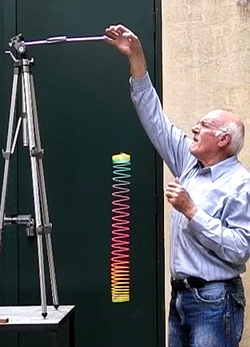 A falling Slinky. Image taken from
A falling Slinky. Image taken from phys.org/news/2012-12-falling-slinky.html
When dropped after being allowed to dangle vertically, a Slinky exhibits a fascinating property – the bottom portion of the Slinky seems to hang motionless in midair for a fraction of a second.
To understand why this seeming levitation occurs, we need to consider the forces acting on this Slinky. Assuming a vacuum, the pertinent forces acting on this Slinky as a whole are the force of gravity, a tension force from the object holding the top of the Slinky, and spring tension within the Slinky.
Initially, the Slinky is stretched out in hanging equilibrium. Once the top end is let go, the Slinky is free to collapse and assume its normal state of equilibrium. However, this does not happen instantaneously, nor does it begin at all places of the Slinky simultaneously. It begins at the top of the Slinky, where the net force acting is now downward. The bottom of the Slinky, however, is still in hanging equilibrium. The bottom never experienced the force of tension from the object holding the Slinky, only the tension force from the portion of Slinky immediately above it (along the spring).
The top of the Slinky, free to collapse, now does so. As each turn of the Slinky collapses, tension within the Slinky is relieved. This collapse and release of tension demonstrates a longitudinal wave travelling downward through the Slinky. Once the wave has reached the bottom of the Slinky and relieved all tension acting opposite gravitational force, the Slinky begins falling as a cohesive unit.
It is interesting to note that, although the bottom of the Slinky remains momentarily stationary, the center of mass of the Slinky actually accelerates due to gravity as expected by kinematic equations (Kolkowitz). The levitation observed does not change the behavior of the system as a whole.
Another interesting fact about hanging Slinkies is that the period of time that a given Slinky will 'levitate' above the ground is not dependent on the strength of the gravitational force acting on it (Kolkowitz). In other words, a Slinky dropped on Earth will take the same amount of time to collapse as the same Slinky on Jupiter or on the Moon. This is because, although a weaker gravitational force produces less tension in a Slinky, a proportional lessening of hanging equilibrium length is also observed. The same proportionality applies to stronger gravitational forces. A Moon Slinky will contract at a fraction of the speed of an Earth Slinky, but it only expanded a fraction of an Earth Slinky's length in the first place.
To understand why this seeming levitation occurs, we need to consider the forces acting on this Slinky. Assuming a vacuum, the pertinent forces acting on this Slinky as a whole are the force of gravity, a tension force from the object holding the top of the Slinky, and spring tension within the Slinky.
Initially, the Slinky is stretched out in hanging equilibrium. Once the top end is let go, the Slinky is free to collapse and assume its normal state of equilibrium. However, this does not happen instantaneously, nor does it begin at all places of the Slinky simultaneously. It begins at the top of the Slinky, where the net force acting is now downward. The bottom of the Slinky, however, is still in hanging equilibrium. The bottom never experienced the force of tension from the object holding the Slinky, only the tension force from the portion of Slinky immediately above it (along the spring).
The top of the Slinky, free to collapse, now does so. As each turn of the Slinky collapses, tension within the Slinky is relieved. This collapse and release of tension demonstrates a longitudinal wave travelling downward through the Slinky. Once the wave has reached the bottom of the Slinky and relieved all tension acting opposite gravitational force, the Slinky begins falling as a cohesive unit.
It is interesting to note that, although the bottom of the Slinky remains momentarily stationary, the center of mass of the Slinky actually accelerates due to gravity as expected by kinematic equations (Kolkowitz). The levitation observed does not change the behavior of the system as a whole.
Another interesting fact about hanging Slinkies is that the period of time that a given Slinky will 'levitate' above the ground is not dependent on the strength of the gravitational force acting on it (Kolkowitz). In other words, a Slinky dropped on Earth will take the same amount of time to collapse as the same Slinky on Jupiter or on the Moon. This is because, although a weaker gravitational force produces less tension in a Slinky, a proportional lessening of hanging equilibrium length is also observed. The same proportionality applies to stronger gravitational forces. A Moon Slinky will contract at a fraction of the speed of an Earth Slinky, but it only expanded a fraction of an Earth Slinky's length in the first place.